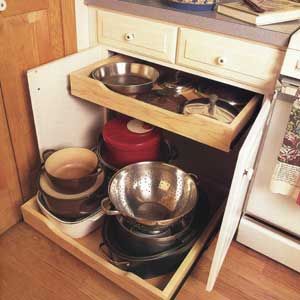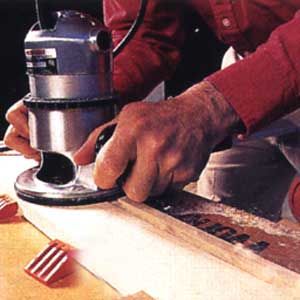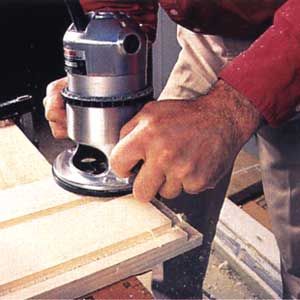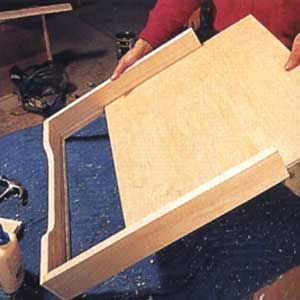
We may be compensated if you purchase through links on our website. Our team is committed to delivering honest, objective, and independent reviews on home products and services.
Every homeowner could use more kitchen storage space. Instead of expanding your kitchen or adding an island, the most efficient approach is to upgrade existing cabinetry to make better use of your storage space. Our approach is to build full-extension glide-out shelves for base cabinets. In this article, we’ll walk you through the process of measuring, building, and installing these shelves to help you get the most out of your kitchen cabinets.
Benefits of Glide-Out Shelves
Installing complex shelves in existing cabinet space makes it far more usable. Here is a look at the biggest benefits of glide-out shelves.
Enhances Kitchen Organization
With glide-out shelves, organizing your kitchen becomes much simpler. You can categorize items and keep similar products together, reducing the time spent searching for what you need.
Improves Accessibility
If you have mobility issues or simply find it hard to bend and reach, glide-out shelves can offer a perfect solution. You can pull out the entire shelf to access items without straining or stretching.
Maximizes Storage Space
Glide-out shelves make it easier to reach items stored in the back of your cabinets. This is especially beneficial for lower cabinets, where it can be difficult to see and access everything. By using glide-out shelves, you can efficiently use the full depth of your cabinets without losing items in the back.
Assessing Your Existing Cabinet Space
If you’re determined to make the most of your cabinet space, do a little planning beforehand to pin down the specifics of this project.
Measure the Cabinet Interior
First, measure the width, depth, and height of your cabinet interiors. Use a tape measure to get accurate dimensions, and consider the space occupied by hinges and door openings. Write down these measurements, as they’ll guide your material purchase and shelf construction.
Evaluate Shelf Placement
Decide where you want to install your glide-out shelves. Factor in the height of the items you plan to store and ensure there’s enough space between shelves for easy access. You might choose to install multiple glide-out shelves in one cabinet or spread them across multiple cabinets, depending on your needs.
Choosing the Right Materials for Your Glide-Out Shelves
Selecting the right materials is crucial for the durability and functionality of your glide-out shelves. You’ll need a combination of sturdy wood, heavy-duty hardware, and proper tools for this project.
Wood Selection
Opt for high-quality plywood or solid wood for your shelf bases and sides. Plywood is generally more cost-effective and easier to work with, but solid wood offers a premium look and feel. We opted for a combination of poplar, which is lightweight and easy to work with, and birch plywood. Ensure that the wood is smooth and free from knots or defects, as these can weaken the structure.
Hardware Requirements
Invest in durable, full-extension drawer slides that can support the weight of your shelves and stored items. These slides must fit the depth of your cabinet space. In addition to the slides, you’ll need vertical shelf standards to attach to the inside of the cabinets and standard brackets to attach the standards to the slides. Some manufacturers may sell these bundled together, but others may require you to buy them separately.
Tools Needed
Make sure you have the following tools:
- Clamps
- Drill/driver
- Finishing sander
- Level
- Measuring tape
- Paintbrush
- Router with 1/2-inch straight bit
- Screwdriver
- Table saw with dado blade
All Materials
Here are the materials we selected for this project:
- Two 8-foot poplar 1x4s
- Half-sheet of 1/2-inch birch plywood
- Accuride Series 3832 full-extension drawer slides (one pair per shelf)
- Accuride shelf standard brackets (set of four per shelf)
- Shelf standards (set of four per cabinet)
- Screws (5/8-inch)
- Finishing nails (One 1/4-inch)
- Wood glue
- Sandpaper (120-grit and 180-grit)
- Sanding sealer
Step-by-Step Building Guide for Glide-Out Shelves
Step 1: Measuring the Shelves
Before cutting any lumber, determine the width of the glide-out shelves. Our standards and brackets took up 1 and 1/4 inches each, plus a 1/2 inch for each slide. That meant subtracting 3.5 inches from the width of the cabinet interior. Our shelves measured 22 inches deep by 25.5 inches wide.
Step 2: Cutting the Wood
Based on your cabinet measurements, cut the wood to size for the shelf base (plywood) and sides (1x4s). You’ll need five pieces per shelf: one for the base and four for the front, back, and sides. Use your width measurement for the front and back pieces (here, 25.5 inches), but subtract 3/4 of an inch from the depth measurement from the sides to allow them to fit into the rabbets you’ll cut in the next step. For a cabinet depth of 22 inches, that meant two side pieces 21 and 1/4 inches long. Sand the edges to remove any roughness and ensure smooth surfaces.
Step 3: Routing the 1x4s
Here, you’ll use a router with a 1/2-inch bit or a table saw with a dado blade to route the 1×4 pieces. To ensure accuracy, fasten an edge-guide attachment to the router base. Adjust the guide to cut the groove half an inch from the bottom edge of the board.

Rout a 3/8-inch-deep by a 1/2-inch-wide groove into each board. Move into the board from left to right with the guide tightly pressed against the edge of the board.

Next, clamp the front and back pieces together and adjust the guide for a 3/4-inch-wide cut. Move the router from left to right across the ends of the boards to cut a 3/8-inch-deep by 3/4-inch-wide rabbet.
Step 4: Assembling the Shelf

Once all the joints are milled, spread glue onto the shelf-front rabbets and attach the shelf sides with finishing nails. Squeeze a little glue into the groove in the shelf front, slide in the bottom and nail on the rear of the shelf.

Let the glue dry for four hours, then smooth all surfaces with a finishing sander and 120-grit sandpaper. Wipe off all dust and coat the shelf with sanding sealer. After about an hour, lightly hand-sand the shelf with 180-grit sandpaper and apply a second coat of sealer.
Step 5: Installing the Standards
Position the front standards 2.5 inches from the inside edge of the face frame. On a frameless cabinet, measure from the front edge of the cabinet. Follow the manufacturer’s instructions for accurate placement.
Based on our cabinet dimensions, we installed the rear standards 17 and 1/16 inches from the first set, measuring from the center of one to the center of the other. Use a level to make sure they’re perfectly vertical, then secure them with 5/8-inch screws.
Step 6: Installing the Brackets and Slides
Bolt two metal shelf-standard brackets to each drawer slide, making sure they have the same measurement as the step above (for us, 17 and 1/16 inches) from center to center. To mount the slides, snap the clips into the slots in the standards. Detach the sliding rail from each slide by depressing its release lever, and fasten a rail to each side of the shelves with screws.
Step 7: Installing the Shelves
To install each shelf, align its sliding rails with the slides inside the cabinet and push it all the way in. The rails will automatically lock into place. Test the glide-out mechanism to ensure that it operates smoothly.
Troubleshooting Tips
Encountering issues during your project is not uncommon. Here are some troubleshooting tips to help you out.
Shelf Doesn’t Glide Smoothly
If your shelf doesn’t glide smoothly, check for misalignment of the drawer slides. Adjust the slides to ensure they’re level and aligned correctly. Lubricating the slides can also enhance their operation.
Shelf Feels Unstable
An unstable shelf may be due to loose screws. Tighten all screws and ensure the shelf is securely attached to the drawer slides. Reinforce the standards or brackets if necessary to provide additional stability.
Alternative Options for Glide-Out Shelf Construction
If building glide-out shelves from scratch seems daunting, there are alternative options you can consider to achieve similar results.
Premade Glide-Out Shelves
Many home improvement stores offer premade glide-out shelves that you can easily install in your cabinets. These shelves come in various sizes and materials, allowing you to choose the best fit for your kitchen. While this option may be more expensive than do-it-yourself (DIY), it saves time and effort.
Professional Installation
If you’re not confident in your DIY skills, hiring a professional to install glide-out shelves is a viable option. Professionals ensure precise measurements and installation, providing a high-quality finished product. Although this option requires you to pay for both materials and labor, it guarantees a hassle-free experience.
